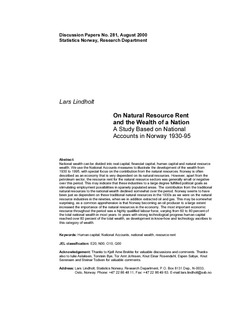On natural resource rent and the wealth of a nation: a study based on National Accounts in Norway 1930-95
Working paper

Åpne
Permanent lenke
http://hdl.handle.net/11250/180103Utgivelsesdato
2000Metadata
Vis full innførselSamlinger
- Discussion Papers [1003]
Sammendrag
National wealth can be divided into real capital, financial capital, human capital and natural resource wealth. We use the National Accounts measures to illustrate the development of the wealth from 1930 to 1995, with special focus on the contribution from the natural resources. Norway is often described as an economy that is very dependent on its natural resources. However, apart from the petroleum sector, the resource rent for the natural resource sectors was generally small or negative over this period. This may indicate that these industries to a large degree fulfilled political goals as stimulating employment possibilities in sparsely populated areas. The contribution from the traditional natural resources to the national wealth declined somewhat over the period. Norway seems to have been just as dependent on these traditional natural resources in the 1930s as we were on the natural resource industries in the nineties, when we in addition extracted oil and gas. This may be somewhat surprising, as a common apprehension is that Norway becoming an oil producer to a large extent increased the importance of the natural resources in the economy. The most important economic resource throughout the period was a highly qualified labour force, varying from 60 to 80 percent of the total national wealth in most years. In years with strong technological progress human capital reached over 80 percent of the total wealth, as development in know-how and technology ascribes to this category of wealth.